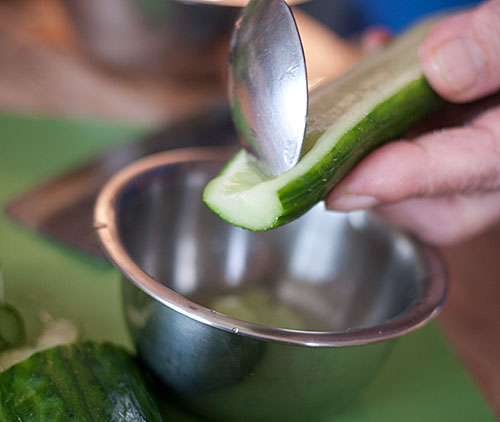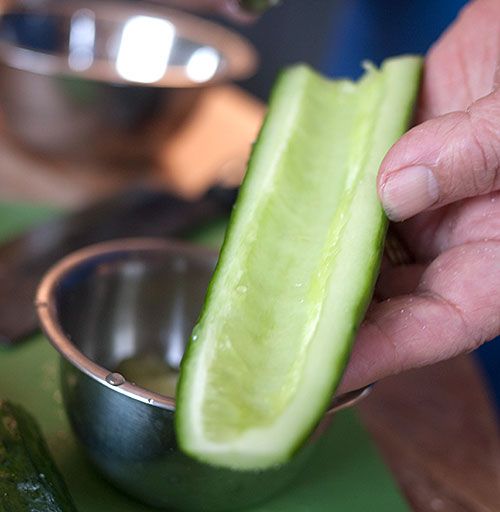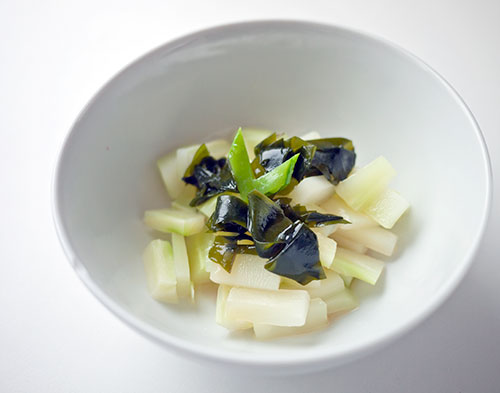Japanese Cooking 101, Lesson 4, Part 2: Prepping Vegetables For Sunomono
Now that we know how to make the vinegar sauces for sunomono, let's turn our attention to the prepping of the vegetables. The key to good sunomono, and all aemono (mixed-vegetable dishes), is to use vegetables that have had the excess moisture removed. The way to do this is to either drain them well, salt them lightly to draw out the moisture, or to blanch them briefly.
Here are some ways to prep vegetables for sunomono. The recipes for the the vinegar sauces (--su or --zu) mentioned are in Part 1.
Wakame seaweed
Wakame is one of the easiest sea vegetables or seaweed to work with. I've been trying to eat more wakame recently since it is packed with minerals, so I'm just going to include it in all the sunomono variations below. It can also be used in miso soup, as I showed in Lesson 1a.
Wakame comes either in dehydrated form or 'raw' and preserved in salt. If you have the latter kind, simply rinse it well in running water, then soak for a few minutes in a bowl of fresh water. If you have the dehydrated kind, soak in plenty of water to cover until it's rehydrated. Either way, it should look like this after a while.

The dehydrated kind usually comes pre-cut into pieces but the salted kind comes in long pieces like so.

Just cut it up into small, bitesize pieces.

Here's about 1/2 cup of ready to go wakame, which can be used in sunomono, soups, salads and so forth.

Cucumber
Cucumber is one of the most versatile vegetables for sunomono. It's available year-round (although its real season is summer), and its crunchy-crisp texture lends itself well to vinegar sauce. Japanese cucumbers are quite small and narrow, but just about impossible to get outside of Japan, so I usually use the type of cucumber that's called an English cucumber - long, and sometimes sold individually shrinkwrapped. Since cucumbers have a high water content we need to remove some of that.
Cut the cucumber in half lengthwise, and rub the surface with a little salt. This adds salt flavor, draws out excess moisture, and also makes the dark green skin really pop in color. Plus, if you have very fresh cucumbers with sharp little thorns, the salt will rub those off.

Scoop out the seeds with a spoon.

Be sure to be thorough and remove all the seeds, like so. (Tip: Don't throw away the seeds and pulp! Chill it in the refrigerator, then use it to give yourself a cool cucumber-skin treatment; apply it over your face, lie down for about 30 minutes, and wash off. Your skin will feel super-smooth and refreshed.)

Cut up the cucumber into fairly thin slices. Sometimes I like to slice it paper-thin, and sometimes I slice it a bit thicker as I have here. Massage the cucumber to distribute the salt, then squeeze out as much excess moisture as you can.

Cucumber and wakame sunomono with ponzu
Cucumber sunomono lends itself to any kind of awase-zu, but I especially like it with the citrusy flavor of ponzu. I used the Ultra Simple version of ponzu here and it was great. Use 1 to 1 1/2 tablespoons of sauce per cup of vegetables, or to taste.

Small turnips
Not all turnips are suitable for using uncooked like this, but small turnips work very well. These little white turnips are perfect.

If you can get turnips with their green tops still on, cut the greens off to leave a little bit on the root. (Use the greens for making homemade furikake.) Carefully peel the turnips so you leave that little green topknot intact.
Tip: The outer part of some kinds of turnips (like these white ones) is rather tough and fibrous, so you should peel them rather thickly. I know it seems wasteful, but the turnips will be a lot more edible.

Then slice the turnips lengthwise, so you have a bit of that green with each slice (except for the sides). Sprinkle the slices with a tiny bit of salt, massage as with the cucumber, and squeeze out tightly to express any extra moisture.

Turnip and wakame sunomono with sanbai-zu
The sweetness of sanbai-zu brings out the sweetness in the turnips. This is just as good without the wakame. Use 1 to 1 1/2 tablespoons of sauce per cup of vegetables, or to taste.

Tip: cutting the turnips with the green tops on makes the slices very attractive in miso soup too.

Broccoli stems and wakame with tosa-zu
This is a very frugal dish, making use of a part of broccoli that most people just throw away. To prep the broccoli stems, cut off the florets (to use for another dish). Peel the tough green outer parts of the stems, and cut them into bitesize pieces. Blanch the pieces in boiling water for about 2-3 minutes until crisp-tender, drain and cool. The umami-rich flavor of tosa-zu goes very well with broccoli and wakame. You can add one broccoli floret as a green accent, or use another green accent like the snap pea piece I've used here. Use 1 to 1 1/2 tablespoons of sauce per cup of vegetables, or to taste.

What other vegetables can you use?
Many vegetables work as sunomono. As I wrote above, you just need to make sure that you get rid of any excess moisture. For instance:
- Daikon radish: Slice thinly, salt and squeeze out.
- Radishes: Slice thinly or into halves or quarters, salt and squeeze out.
- Cabbage: Cut up roughly, salt and squeeze out.
- Tomatoes: De-seed and get rid of the pulp. Drain in a sieve to let any excess moisture run off.
- Lettuce: Make sure to pat away any water on the leaves. Rip up the leaves with your hands to avoid the browninng you get when you cut lettuce with a steel knife, or use a stainless steel or ceramic knife to chop up the leaves. Serve immediately after mixing with the vinegar sauce. (Lettuce and wakame with nihai-zu works very well, as does ponzu.)
- Celery: Peel off the tough outer fibers of the stalks. Slice very thinly, and sprinkle with a tiny of salt and squeeze out. Celery works well with sanbai-zu or ama-zu.
- Mizuna: Blanch in plenty of boiling water, cool in cold water and squeeze out tightly. Cut into short lengths. Mizuna goes well with any of the sauces, but I like it best with simple nihai-zu or ponzu.
- Edible chrysanthemum flowers: Blanch briefly in boiling water and drain. This is used most often together with other vegetables, such as daikon radish, and is really pretty.
A few vegetables may not be so suited to vinegar flavor (brussel sprouts come to mind for one) but that's really a matter of taste. I hope you'll try out your favorite vegetables as sunomono and see how they turn out.
Other ingredients uses in sunomono
Boiled seafood such as boiled shrimp, octopus and squid are often used in sunomono. Boiled shrimp is easy to do at home. If you want to try octopus, buy a piece of sashimi-ready octopus at a Japanese grocery store. (Raw octopus needs to be massaged and beaten up to make it tender enough before boiling.) Poached chicken also works well, especially with nanban-su.
You can find dehydrated seaweed salad mixes at Japanese or Korean grocery stores. To use these just soak in water as for the wakame until they are rehydrated and pliable. Use any of the vinegar sauces - for a Korean twist, add a bit of sesame oil and grated garlic.
Harusame is a noodle made from potato starch that is used in sunomono. It requires special treatment so I'll post a separate recipe with it at a later date.
If you think about it, sunomono sauces are rather like oil-free dressings, so they can be used with any number of salad-like combinations. The oil-free dressings sold in Japan are actually just variations on sunomono sauces.
I hope you've enjoyed this trip through sourness. In the next lesson we'll finally get to the main protein dish of a Japanese meal.
Filed under: japanese vegetables vegetarian vegan washoku japanesecooking101